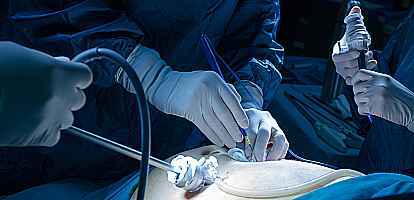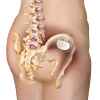Introduction
Sacral neuromodulation (SNM) is commonly known as a bladder pacemaker. This treatment is used to help patients with bladder control problems.
The brain controls the bladder by sending electrical signals down nerve pathways that run from the brain to the spinal cord, and through the lower back called the sacral area. These sacral nerves control the muscles in the pelvic floor, the bladder and those needed for urinary control. Bladder sensations (such as fullness) are also relayed via these nerves to the brain. Sacral neuromodulation helps to correct inappropriate, unwanted or even erroneous messages sent along these nerve pathways.
There are two companies that provide SNM devices in Australia: Medtronic and Axonics. Since July 2021, an MRI-compatible version has been available. There are rechargeable and non-rechargeable versions of the battery. The rechargeable one is smaller and needs about an hour of charging every 1 to 2 months. The non-rechargeable version has a battery life of 4 to 6 years on average. Longer battery life versions will be available in the near future.
How does it work?
SNM uses mild electrical pulses to stimulate the sacral nerve located near the tailbone, which controls the bladder and other muscles that manage urinary function. A pulse generator device (battery) the size of a stopwatch, is surgically implanted into the buttocks. The pulses are delivered near the sacral nerve through an insulated wire called a ‘lead’, which is also implanted under the skin.
How do I know if it will work for me?
SNM is done in 2 stages; the first is the Testing Phase and the second is the Implant Phase. The testing phase allows patients to have a 2-week trial period before deciding whether they should have a permanent device (battery) implanted in them. If the bladder symptoms improve, the implant stage is then carried out. If not, the testing lead is simply removed.
Am I eligible for it?
Under the Medicare Benefits Schedule (MBS), patients (>18 years old) with:
- Patients with an overactive bladder confirmed with urodynamics study.
- Patients with non-obstructive urinary retention (unable to pass urine) - underactive bladder that has not improved with medical or conservative treatment for at least 12 months, are eligible.
Have clinical trials been done on it?
Yes, clinical trials have been done and published over the years, showing good results and safety. Government agencies like the American Food and Drug Administration (FDA) and the Australian Therapeutic Goods Administration (TGA) have approved its use. The trials also show that SNM has successfully treated certain bladder control problems in patients for whom other treatments did not work.
What kind of results can I expect from SNM?
Noting that results may vary for each patient, here are the results 12 months after surgery:
- Urge incontinence (leakage associated with overwhelming sensation to pass urine):
- 45% of patients remained totally dry.
- 34% of patients reduced the number of wetting episodes by at least 50%.
- 70% of patients eliminated heavy leaking episodes.
- Overall clinical success rate of 79% for urge incontinence.
- Urgency-frequency (strong bladder sensations and frequent urinations):
- 31% of patients reduced the number of voids to normal (4-7 per day).
- 33% of patients reduced the number of voids by 50% or more.
- 82% of patients improve the degree of urgency before voiding.
- The overall clinical success rate of 64% for urgency-frequency.
- Urinary retention (unable to pass urine):
- 61% of patients eliminated the use of catheters.
- 16% of patients reduced the amount of urine emptied from the bladder using a catheter by 50%.
What are the side effects?
The SNM procedure is very safe and has not been associated with any death. The majority of adverse events experienced were of a relatively minor nature. In a report to the Medical Services Advisory Committee of Australia, the most commonly reported clinical adverse events were:
- Experiencing pain of undefined location and severity (22%).
- Experiencing pain specifically at the implanted pulse generator site (14%).
- Infection (5.8%).
- Lead migration (movement of the lead to a different position such that some efficacy becomes lost) was reported at 7%.
- Approximately 16 % of patients required lead revision or replacement, frequently in order to optimise the clinical effectiveness of the device.
- Device removal was reported at a rate of 9.9% in the implanted patients. This is usually done because of infection, lost efficacy, or pain.
If you want to know whether sacral neuromodulation can help your bladder problems, contact us.
For more specific information on the Testing Phase procedures and instructions and the Implant Phase read Sacral Neuromodulation - User Info. This link has information on how to prepare for the surgery, instructions during the trial, and what to expect after the surgery.
Related Information
A/Prof Gani has extensive clinical experience in sacral neuromodulation (SNM), and has published many papers in this field. He has run multiple workshops and proctored many other clinicians.
Read A/Prof Gani’s publication - Systematic review on SNM’s role in the treatment of non-obstructive urinary retention:
Download Efficacy of sacral neuromodulation and percutaneous tibial nerve stimulation in the treatment of chronic nonobstructive urinary retention - PDF (1200 Kb)
Read A/Prof Gani’s publication - SNM has better results in patients with underactive bladder, who still have preserved bladder contractility:
Download Evaluation of pre‑operative bladder contractility as a predictor of improved response rate to a staged trial of sacral neuromodulation in patients with detrusor underactivity - PDF (580 Kb)
Read A/Prof Gani’s publication - SNM is a reasonable treatment option for patients with detrusor overactivity with concurrent underactivity.:
Download Sacral neuromodulation for detrusor hyperactivity with impaired contractility - PDF (1500 Kb)
Read A/Prof Gani’s publication - SNM can have good results in patients who have failed anti-spasm bladder injection for refractory overactive bladder:
Download Sacral neuromodulation for refractory overactive bladder after prior intravesical onabotulinumtoxina treatment - PDF (124 Kb)
Read A/Prof Gani’s publication - SNM in patients with painful bladder syndrome:
Download Sacral neuromodulation in non obstructive urinary retention and painful bladder syndrome - PDF (257 Kb)

